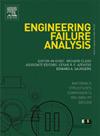Forming simulation and failure analysis of CFRP hole-clinched and adhesive hybrid joints
IF 5.7
2区 工程技术
Q1 ENGINEERING, MECHANICAL
引用次数: 0
Abstract
Carbon fiber reinforced polymer (CFRP) and aluminum alloy hybrid joints are increasingly used in lightweight structures, but their reliability is often affected by process-induced damage during mechanical joining. This study presents the first coupled forming-damage-failure analysis of hole-clinched adhesive hybrid joints, integrating simulations and experiments to reveal the interaction between joining defects and structural performance. A progressive damage model (Hashin) for CFRP, a cohesive zone model for the adhesive interface, and a Johnson-Cook model for aluminum alloy are combined to simulate joint formation and subsequent loading. Results show that the localized defects such as interfacial delamination, adhesive degradation, and fiber–matrix cracking originate during forming and critically influence tensile response. Cross-sectional and scanning electron microscopy (SEM) observations validate the simulations. Comparative tensile tests demonstrate that hybrid joints outperform adhesive joints, with a 23.9% increase in peak load and a 105.6% improvement in energy absorption. Failure analysis confirms a multi-scale damage evolution involving adhesive degradation, fiber fracture, and interlock deformation. This work establishes a predictive framework linking process parameters, damage evolution, and joint reliability, offering guidance for the optimized design of CFRP-metal hybrid connections in advanced lightweight structures.
CFRP孔压与粘接复合接头成形仿真及失效分析
碳纤维增强聚合物(CFRP)与铝合金复合接头在轻量化结构中的应用越来越广泛,但其可靠性往往受到机械连接过程中过程损伤的影响。本文首次提出了一种结合仿真和实验的孔-锁紧胶粘剂混合接头形成-损伤-破坏耦合分析方法,揭示了连接缺陷与结构性能之间的相互作用。结合CFRP的渐进损伤模型(Hashin)、粘结界面的内聚区模型和铝合金的Johnson-Cook模型来模拟接头的形成和后续加载。结果表明,界面分层、粘结剂降解和纤维基体开裂等局部缺陷产生于成形过程中,对拉伸响应有重要影响。横断面和扫描电镜(SEM)观察验证了模拟。对比拉伸试验表明,混合接头优于粘结接头,峰值载荷提高23.9%,能量吸收提高105.6%。失效分析证实了包括粘合剂降解、纤维断裂和联锁变形在内的多尺度损伤演变。建立了连接工艺参数、损伤演化和节点可靠性的预测框架,为先进轻量化结构cfrp -金属混合连接优化设计提供指导。
本文章由计算机程序翻译,如有差异,请以英文原文为准。
求助全文
约1分钟内获得全文
求助全文
来源期刊

Engineering Failure Analysis
工程技术-材料科学:表征与测试
CiteScore
7.70
自引率
20.00%
发文量
956
审稿时长
47 days
期刊介绍:
Engineering Failure Analysis publishes research papers describing the analysis of engineering failures and related studies.
Papers relating to the structure, properties and behaviour of engineering materials are encouraged, particularly those which also involve the detailed application of materials parameters to problems in engineering structures, components and design. In addition to the area of materials engineering, the interacting fields of mechanical, manufacturing, aeronautical, civil, chemical, corrosion and design engineering are considered relevant. Activity should be directed at analysing engineering failures and carrying out research to help reduce the incidences of failures and to extend the operating horizons of engineering materials.
Emphasis is placed on the mechanical properties of materials and their behaviour when influenced by structure, process and environment. Metallic, polymeric, ceramic and natural materials are all included and the application of these materials to real engineering situations should be emphasised. The use of a case-study based approach is also encouraged.
Engineering Failure Analysis provides essential reference material and critical feedback into the design process thereby contributing to the prevention of engineering failures in the future. All submissions will be subject to peer review from leading experts in the field.
 求助内容:
求助内容: 应助结果提醒方式:
应助结果提醒方式:


